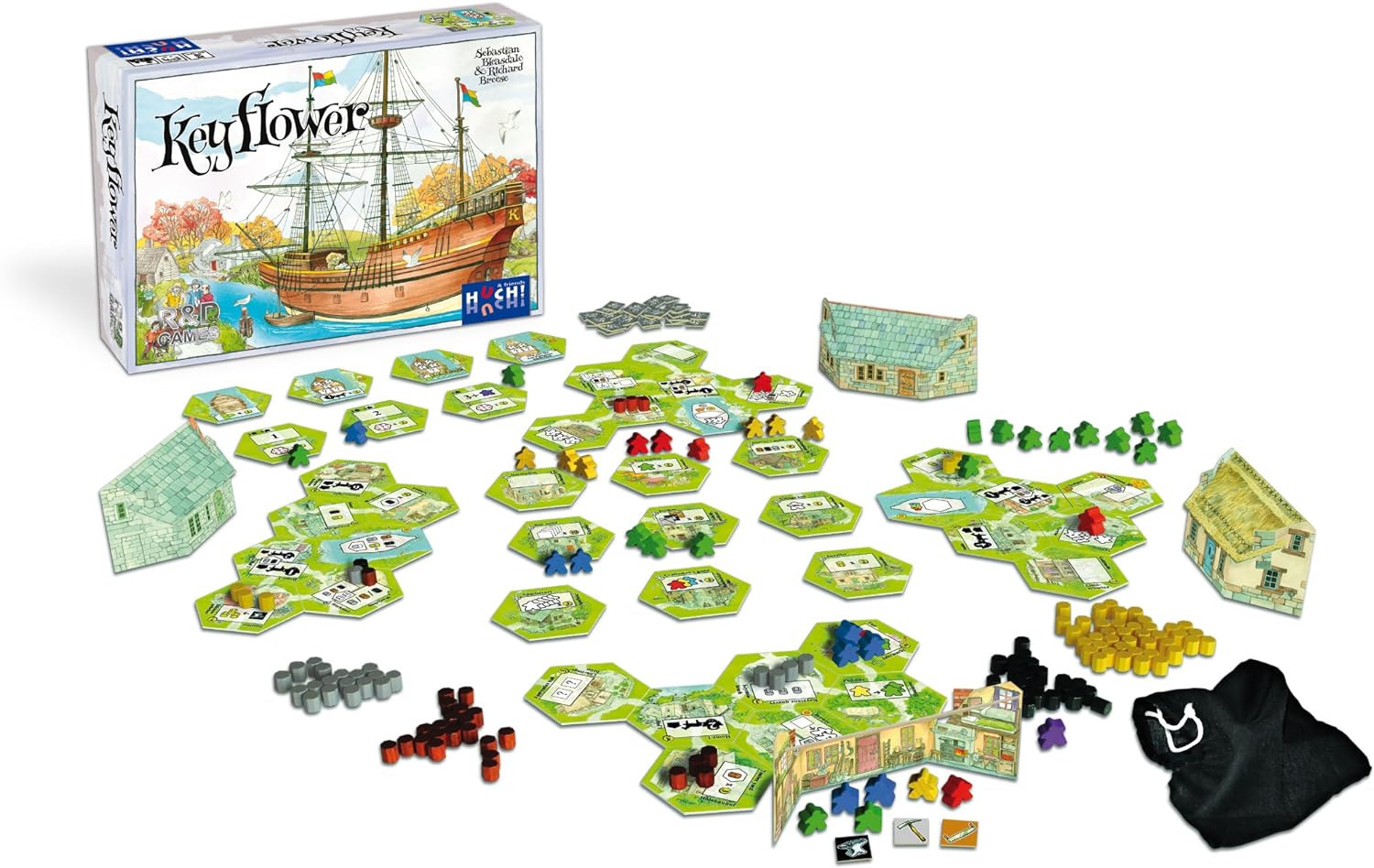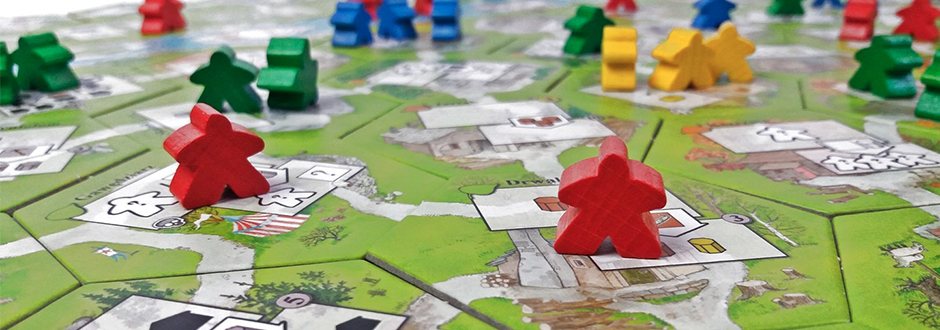As a player who has experienced this lovely board game, I can honestly say that Keyflower beautifully combines various game mechanics that exist in many other into a seamless and engaging experience. Keyflower is a strategic masterpiece that challenges players to build and develop their own villages while competing against others for limited resources and tiles.
Playing Keyflower involves not only efficient resource management and careful worker placement but also a unique auction system that adds an element of negotiation and interaction with fellow players. This game rewards adaptability and forward-thinking as you must adjust your strategy based on the changing seasons and the tiles available for bidding. The “key” mechanic, where the color of your workers determines ownership and control, adds depth and complexity to decision-making, making each turn a thrilling puzzle to solve.
What’s included in Keyflower

- Tiles: Keyflower includes various types of tiles, such as hexagonal resource tiles (wood, stone, iron, gold), buildings, transport ships, and skill tiles.
- Meeples: Different-colored meeples represent your workers, and each color corresponds to a specific season (red for autumn, blue for winter, and yellow for summer).
- Key Cards: These cards are used for bidding and are numbered from 1 to 6.
- Auction Screens: Each player has a screen to hide their bids.
- Player Screens: These screens hide your resources and meeples.
- Scoring Tokens: These tokens track your score.
- Turn Order Marker: Determines player order.
- Resource Tokens: These represent wood, stone, iron, and gold.
- Tiles: Set up a random assortment of tiles in the center of the table. Each season, tiles will be added or removed from this display.
How to play Keyflower

Keyflower is a complex and deep board game that combines worker placement, auction, and resource management mechanics. It’s played over a series of rounds, each representing a different season in the game year. Here’s a detailed step-by-step guide on how to play Keyflower:
Setup
- Randomly place the tiles in the center to create the initial display.
- Give each player a set of meeples (red, blue, and yellow), an auction screen, and a player screen.
- Shuffle the key cards and deal four to each player. Players keep these cards secret behind their screens.
- Place the scoring tokens, resource tokens, and turn order marker within reach of all players.
Rules for Keyflower
Keyflower is played in a series of rounds, each representing a season: spring, summer, autumn, and winter. Here’s a detailed breakdown of each round:
1. Spring (Auction Phase)
- In each season, players will take turns being the “start player,” which determines the turn order.
- The start player chooses a tile from the central display and places it next to their player screen, designating it as a “bid tile.” Other players may place meeples from their personal supply onto the same tile to indicate interest in bidding on it.
- Bidding is done using meeples from behind your auction screen. Players take turns placing meeples of any color on their bid tile, starting with the start player. The number of meeples you place represents your bid.
- To outbid another player, you must place meeples of a higher color. For example, to outbid a yellow meeple, you can place a blue or red meeple.
- Continue bidding until all players pass. The winner of the tile pays their bid by returning the meeples to their supply and places the tile in their village. If no one bids on a tile, it is discarded from the game.
2. Summer (Placement Phase)
- Players take turns placing meeples from behind their player screens onto tiles in their villages. You can either place meeples on tiles you won in the current season’s auction or tiles in your village from previous seasons.
- Meeples placed on a tile become workers for that tile, contributing to its actions or resource production.
3. Autumn (Scoring Phase)
- Scoring takes place in autumn for tiles that have a scoring mechanism. Some tiles score points immediately, while others score at the end of the game.
- Use the skill tiles and buildings in your village to manipulate the scoring mechanisms and maximize your points.
4. Winter (Resource Collection Phase)
- In winter, players collect resources produced by their tiles. Each tile indicates the resource type and quantity it produces.
- Players can also convert resources (wood, stone, iron, and gold) into key cards. To do this, place a meeple on a resource tile in your village and discard the required resources to gain a key card. Key cards have special abilities and can be used for bidding or as workers.
5. End of Season
- After winter, remove any tiles that have been emptied of meeples and place them in a separate discard pile.
- Pass the start player marker to the next player clockwise.
Winning the Game: Keyflower is played over four seasons (rounds), and the player with the most points at the end of the game wins. Points are earned through various means, such as scoring tiles, resources, and key cards.
For the official rules, see the links below:
Strategies for Keyflower
1. Balance Your Resources
- Resource management is crucial in Keyflower. Ensure you have a steady supply of wood, stone, iron, and gold to support your bidding and tile placement strategies.
- Convert excess resources into key cards, as these cards can provide powerful abilities and additional workers.
2. Leverage Key Cards
- Key cards offer unique abilities that can be game-changing. Acquire key cards that complement your overall strategy.
- Some key cards provide powerful abilities during the scoring phase. Timing their use effectively can earn you valuable points.
3. Plan for Scoring Opportunities
- Keep an eye on the scoring tiles that come into play. Adapt your village to take advantage of these scoring opportunities.
- Some tiles provide endgame scoring bonuses based on specific conditions. Strategically place meeples and tiles to maximize your points in these categories.
4. Optimize Bid Tile Selection
- Choose your bid tiles carefully. Consider the immediate benefits they offer and their potential long-term value.
- Prioritize tiles that generate resources, provide workers, or enhance your scoring potential.
5. Worker Placement Flexibility
- During the summer phase, consider placing workers on tiles that can provide various resources or actions. Versatile tiles offer flexibility and adaptability.
- Keep track of your opponents’ placements and adapt your strategy to both compete with them and benefit from their actions.
6. Blocking and Denial
- Use your meeples strategically to block opponents from acquiring tiles that are critical to their strategy.
- Denying your opponents access to certain tiles or resources can hinder their progress and limit their options.
7. Timing Is Key
- Timing your actions and bids can make a significant difference. Sometimes it’s beneficial to bid aggressively early in the game to secure essential tiles, while in other instances, a patient approach may pay off.
8. Focus on Transportation
- Transport ships are valuable for moving resources between tiles. Acquire these early to improve the efficiency of your village.
- Transportation can help you fulfill tile requirements and facilitate resource collection.
9. Adapt to Opponent Actions
- Keyflower is highly interactive. Be prepared to adjust your strategy based on your opponents’ moves and what tiles they prioritize.
- Identify and exploit opportunities created by your opponents’ tile placements.
10. Long-Term Planning
- Consider your endgame strategy from the beginning of the game. Building a coherent and synergistic village can lead to a more significant point accumulation.
11. Score Consistently
- Don’t rely solely on one aspect of scoring. Diversify your scoring potential by collecting tiles that contribute to different categories.
12. Be Mindful of Tile Movement
- Tiles can move between players’ villages during the game. Anticipate potential tile acquisitions and plan your bids and placements accordingly.